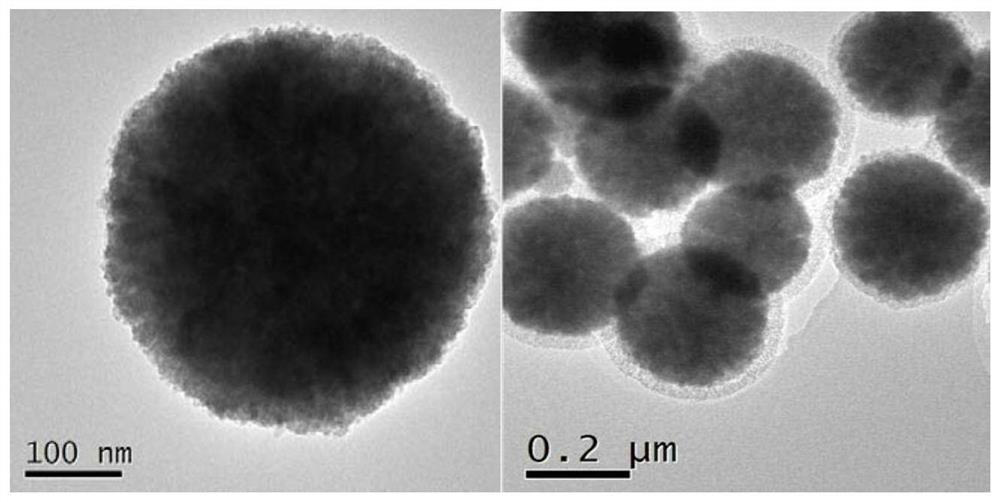A kind of molecularly imprinted microsphere and its application method
A technology of molecularly imprinted microspheres and microspheres, which can be used in chemical instruments and methods, other chemical processes, color/spectral property measurement, etc., and can solve the problems of slow detection speed and complicated analysis steps.
- Summary
- Abstract
- Description
- Claims
- Application Information
AI Technical Summary
Problems solved by technology
Method used
Image
Examples
Embodiment 1
[0076] A method for preparing organophosphorus pesticide residue magnetic molecularly imprinted microspheres, respectively using triazophos, fenthion, and quinthion as template molecules, and vinyl phosphate as a monofunctional monomer, according to the following steps:
[0077] (1) Preparation of superparamagnetic Fe by hydrothermal method 3 o 4 Nanoparticles:
[0078] 1.35g FeCl 3 ·6H 2 O, 3.60 g of sodium acetate and 1.00 g of polyethylene glycol were dissolved in 40 mL of ethylene glycol. Then the mixture was sonicated for 30 min, placed in a polytetrafluoroethylene-lined stainless steel autoclave, sealed, and heated to 200 ° C for 8 h. After magnetic control separation, wash with deionized water for 3 to 6 times, and vacuum dry at 50°C for 8 hours to obtain superparamagnetic Fe 3 o 4 nanoparticles.
[0079] (2) Preparation of Fe by sol suspension method 3 o 4 @CTAB @mSiO 2 Nanoparticles:
[0080] In 100 mL of deionized water, the superparamagnetic Fe 3 o 4 Na...
Embodiment 2
[0089] A method for preparing organophosphorus pesticide residue magnetic molecularly imprinted microspheres, respectively using triazophos, fenthion, and quinthion as template molecules, and using allyl phosphate as a monofunctional monomer, the following steps are carried out:
[0090] The method of steps (1)-(4) is the same as that of Example 1, and can be carried out step by step.
[0091] (5) Synthesis of magnetic molecularly imprinted microspheres of organophosphorus monofunctional monomers by surface imprinting polymerization:
[0092] This step is the same as step (5) of Example 1, except that the functional monomer is replaced by allyl phosphate.
[0093] Simultaneous preparation of Fe without template molecules 3 o 4 @mSiO 2 @NIPs microspheres (MNIPs) for comparative experiments of adsorption performance.
Embodiment 3
[0095] A method for preparing organophosphorus pesticide residue magnetic molecularly imprinted microspheres, respectively using triazophos, fenthion, and quinthion as template molecules, and ethylene phosphate and 1-octadecene as bifunctional monomers, according to Follow these steps:
[0096] The method of steps (1)-(4) is the same as that of Example 1, and can be carried out step by step.
[0097] (5) Synthesis of organophosphorus bifunctional monomer magnetic molecularly imprinted microspheres by surface imprinting polymerization:
[0098] This step is the same as step (5) of Example 1, except that one functional monomer is replaced by two functional monomers: vinyl phosphate and 1-octadecene.
[0099] Simultaneous preparation of Fe without template molecules 3 o 4 @mSiO 2 @NIPs microspheres (MNIPs) for comparative experiments of adsorption performance.
PUM
 Login to View More
Login to View More Abstract
Description
Claims
Application Information
 Login to View More
Login to View More - Generate Ideas
- Intellectual Property
- Life Sciences
- Materials
- Tech Scout
- Unparalleled Data Quality
- Higher Quality Content
- 60% Fewer Hallucinations
Browse by: Latest US Patents, China's latest patents, Technical Efficacy Thesaurus, Application Domain, Technology Topic, Popular Technical Reports.
© 2025 PatSnap. All rights reserved.Legal|Privacy policy|Modern Slavery Act Transparency Statement|Sitemap|About US| Contact US: help@patsnap.com



